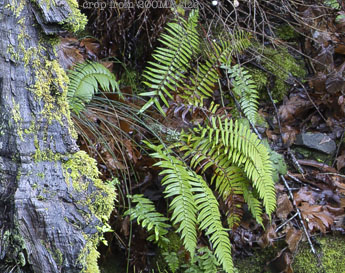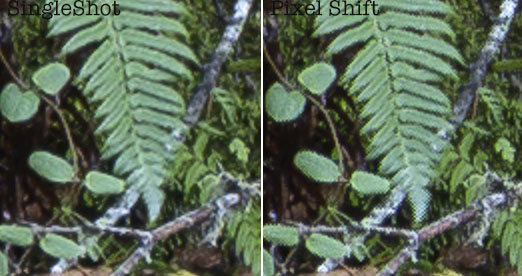Sony A7R V Pixel Shift with Motion Correction a Medium Format Killer?
Coming soon (it’s a fair bit of work). And of course I am not talking about portraiture or things like that, where pixel shift remains non-viable. But landscape, architecture, etc.
Sharpness
Is the new 60-megapixel Sony A7R V with its motion-corrected pixel shift captures competitive with the 100 megapixel Fujifilm GFX100S medium format?
Till now, pixel shift has been a no-go feature due to ugly checkerboarding artifacts and out-of-register color. But Sony seems to have addressed that issue.
My question was this: is a landscape shot with moving water good to go for pixel shift, using the Sony motion correction?
It appears to be a blowout in favor of the smaller sensor, at least when top notch lenses are used, like the Voigtlander 35mm f/2 APO-Lanthar.
By the numbers, the GFX100S has only a 1.23X linear resolution advantage (11648 vs 9504), which is just noticeable. Same photosite size for both. But when pixel shift is added to the mix, it’s no contest, as that’s a 1.2X to 1.4X advantage, particularly on textural detail. Add in better lenses and less diffraction (from wider aperture on 35mm) and it’s a blowout. So these results do not surprise me at all.
The question therefore is how often one can use pixel shift successfully.
Of course, you can flip that around, and crop the 3:2 sensor of the Sony to 4:3, and lose some of its pixels. I’m not going to argue that point as it’s valid if you require a 4:3 aspect ratio. But it won’t change things in a major way.
Noise
It gets better. Cropped to a 3:2 aspect ratio, the GFX100S sensor is only 1.5X larger in terms of area. But with 4-shot pixel shift, 4 captures are made with 4X the light flux, with the A7R V capturing 4/1.5 = 2.67X the light, for a noise level that is 1.63X cleaner (less noisy)—significant when an image is pushed in 'post'. That’s like ISO 37 vs ISO 100!
Probably I will find downsides, eg some kinds of lighting or motion that are problems. But from what I see, if I can do a friggin' creek with 1.8 second exposures with moving water and ferns/plants, pixel shift is suddenly a whole new ballgame.
Stay tuned.
Regular Sony A7R V coverage will be in diglloyd Mirrorless. Detailed cross-format comparisons will be in diglloyd Medium Format.
Below, the Sony A7R V with 4-shot pixel shift scaled to 100MP easily outperforms the Fujifilm GFX100S. And I have even given the GFX100S an unfair advantage; the GFX100S should be at f/10 for format equivalent depth of field, where it suffers considerably more from diffraction dulling than at f/8.

Sony A7R V + Voigtlander FE 35mm f/2 APO-Lanthar vs Fujifilm GFX100S + Fujifilm GF 35-70mm f/4.5-5.6, both at f/8
Below, moving water, without and with Sony motion correction.

Dominik W writes:
Is pixel shift along with focus stacking something you are going to be testing? Are the stacked and pixel shifted images put into the same folders? Curious what the workflow is going to be for that and how much of it can be be automated.
DIGLLOYD: another Sony design screwup is not offering any way to do focus bracketing (focus stacking) with pixel shift. It is either/or, which means you’d have to do the focus bracketing manually.
Dan C writes:
I’m posting this after reading todays post about whether the new A7R V can beat medium format. You sounded enthusiastic, but the there was significant checkerboarding on a fern tip in the example you posted. It left me a bit confused why you were seemingly so pleased with this result. Maybe you didn’t see it? It seemed like an odd choice of image to use for what appeared to be proof that the A7R V was the better option.
By the way, I’m a new A7R V user. So this isn’t some Fujifilm but trying to poke holes. Just pointing it out.
DIGLLOYD: I used that crop to show a very substantial depth, which is important to total sharpness. And I saw it and included those ferns on purpose. There might be a little checkerboarding there, but maybe not: upsizing using Preserve Details 2.0 accentuates things. When I open the image into 100MP resolution (11648 across) directly from raw in ACR, I do not see any checkerboarding. So I think it is mostly an artifact of Preserve Details 2.0.
It’s always possible that I’ve missed something. Sharp-eyed readers will have the whole image to look at and decide for themselves.
When I present the comparison, I intend to show the GFX100S vs (1) the single shot version, (2) pixel shift opened directly at higher res, (3) pixel shift opened then upsampled using Preserve Details 2.0.
Below, actual pixels crop from a 240-megapixel image (19009 X 12673), and without the additional sharpening needed for such a huge upsampling. If it’s checkerboarding, can you see it?

Dan C writes again:
I’m not sure you are looking at the same thing I am. The issue I’m looking at is the fern tip on the left of the log. The crop you are showing me is from the ferns to the right of the log. Not the same thing, and to my eyes, looks different.
DIGLLOYD: agreed that the tip of that fern has issues, see below. If there were a handful of such issues, they could be dealt with by painting over with a single-shot frame. More than that... no thanks.
But worse, the edges of color contrast such as fern leaves have Pac-Man bites out of them. Or do they? Fern leaves have sawtooth edges, I think. Gotta go look at some ferns closeup.
Can Sony’s motion correction deal with lighting changes? Dunno.
Below, actual pixels from a 240MP crop from the 60MP pixel shift image.

























